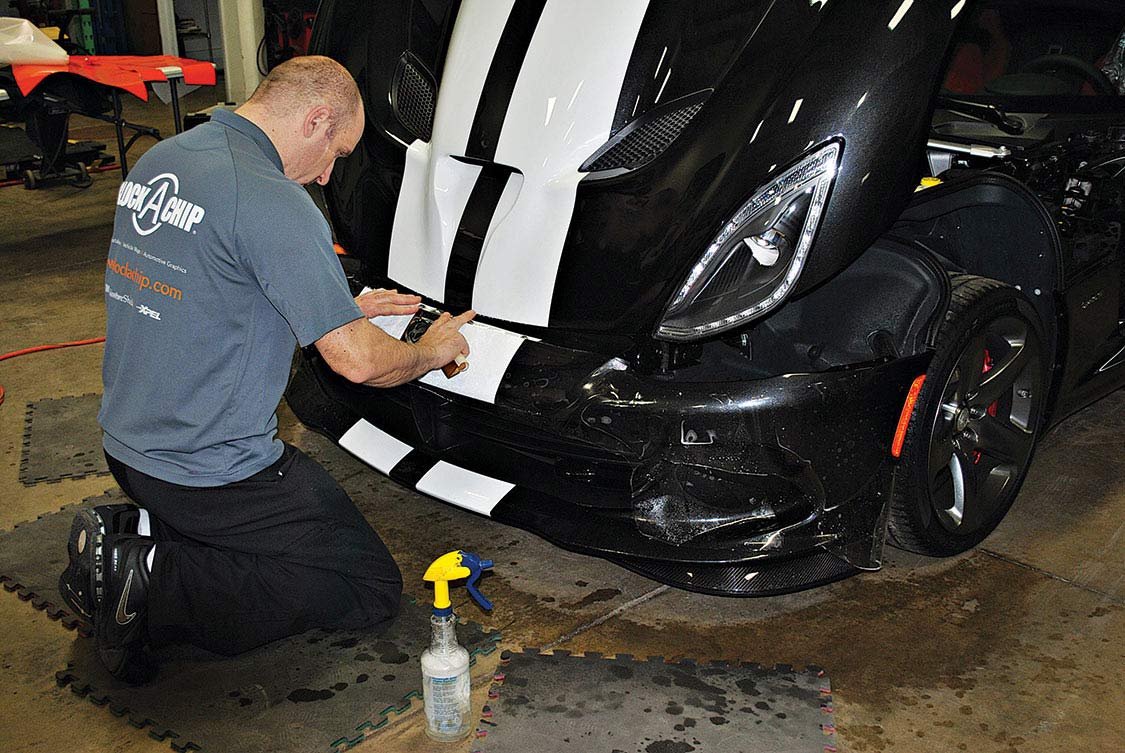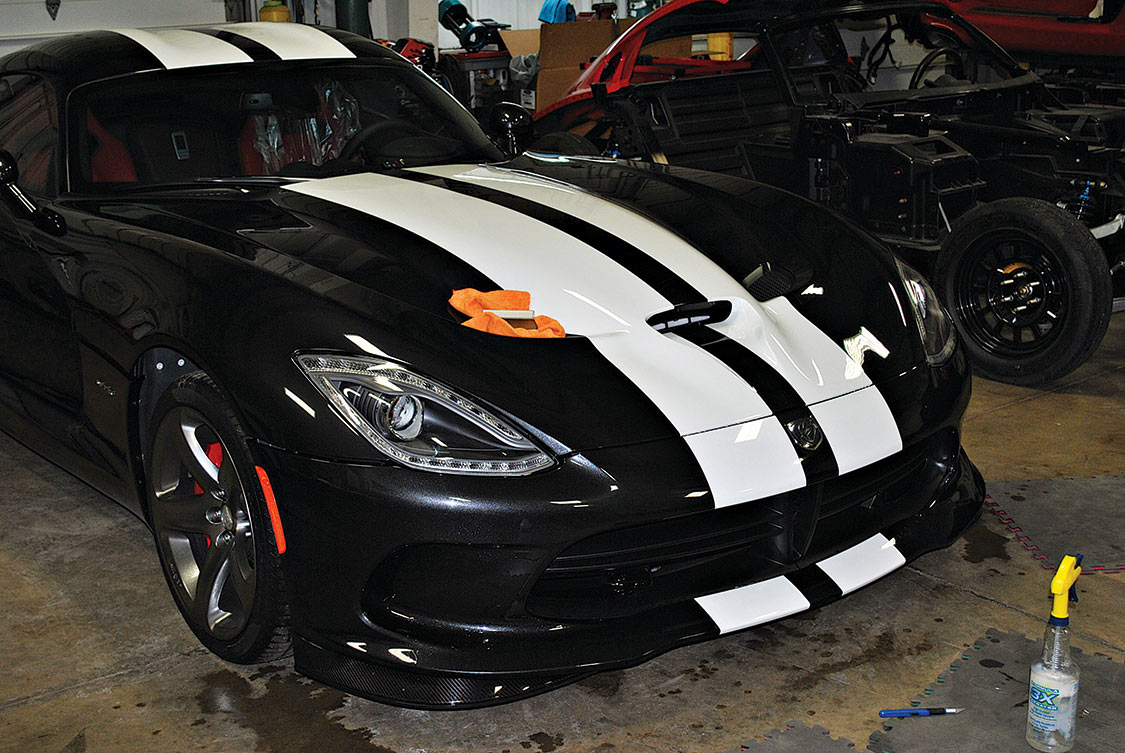 Margo McVay
.
August 08, 2022
.
All Feature Vehicles
Margo McVay
.
August 08, 2022
.
All Feature Vehicles

High octane, high performance, high maintenance – sounds familiar? The good news is you have a dream car, but worrying about how to keep it looking great can be a nightmare. Even if you pamper your baby with tons of TLC, once you are out on the open road your expensive finish can take a pounding from shooting stones, flying gravel and swarms of insects. Until now, there were not a lot of ideal options to preserve your investment and avoid a five-figure repaint.

Strapping on a black vinyl bra has been one traditional method to shield the leading edge, although this could often do more to damage your car’s finish than protected. In the nineties, the use of clear paint protection film became more prevalent and replaced bras, but the reality was these first-generation materials left a lot to be desired. Old-school film was not very flexible, which made it difficult to apply smoothly, and the adhesive often showed through, creating an orange peel effect. Other drawbacks began to rear their ugly heads as the film aged, including a loss of clarity, yellowing and paint fading issues. All in all, not a pretty picture for an appearance-enhancing product!
With the understanding that the concept of paint protection film is a great idea if done right, in 1997, XPEL Technologies was established to begin the pursuit of “building a better mousetrap” in paint protection.
From the outside, paint protection film can look relatively simple, but it is actually quite complex. XPEL incorporated new adhesives, polyurethanes and clear coats to create their ULTIMATE film, a high-performance paint protection product that provides the optimum combination of clarity, flexibility and durability.

The foundation of the film is an easy-to-handle two-mil matte polyester release liner. To that, XPEL applies an ultra-clear acrylic copolymer adhesive formulated to provide optimum tack, resist distortions during installation and create a smoother foundation for the film layer. Then the patent-pending, six-mil aliphatic urethane film layer with excellent flexibility and memory allows for precision installation and creates a thick and invisible paint covering. Topping it off is a revolutionary clear coat that employs special elastomeric polymers that allow scratches and swirls in the surface to heal over time, eliminating the need for frequent polishing to maintain a high-gloss appearance, while also shielding the film from contamination and deterioration.
There are many upgrades that owners can install themselves, but applying sheets of sticky film on a costly car is usually a “don’t try this at home” endeavor. Your car’s finish is worth entrusting to a professionally-trained installer. Installing clear film of any kind takes practice, patience, and finesse to do correctly. Mentor, Ohio XPEL installer Albert Helcberger, owner of Block A Chip LLC, describes the road that led him to becoming an in-demand paint protection film expert.

Helcberger says his love for his dream car, a 50th anniversary Corvette, was the start of his film career. “When I got my car I wanted to preserve my investment, and a co-worker at the graphic design company where I was web director told me about film. In 2002 it was hard to find an installer, so I put it on myself. After seeing how the film was protecting my Corvette and also enjoying the art of installing it, I gradually developed this business,” said Helcberger. Because skilled installation is essential to creating satisfied customers, Helcberger went to the XPEL Training Center in San Antonio to receive in-depth film installation training, and has practiced his craft on hundreds of vehicles over the past twelve years.
Recently, a 2015 Viper received the VIP Block A Chip treatment. Handling the wide clamshell-shaped hood and intricate indentations of the Viper could be a daunting assignment, but for Helcberger it was business as usual. Working with pre-cut film patterns from XPEL’s extensive film pattern library for over 70,000 vehicles, Helcberger deftly applied XPEL to this black beauty. Watching him as he carefully positioned and trimmed each piece made it clear that this is a job for a professional, and that an installer with years of practice and skill can perfectly contour the film for invisible protection and a long-lasting new-car finish.

Before the film was applied to the car, the paint had been thoroughly cleaned and clayed to create the smoothest surface possible. After that, all panel edges are treated with a wax and silicone remover to ensure a firm film bond. Next, Helcberger sprays XPEL’s installation solution across the entire surface and the film is positioned on the area to be covered. Once the film is in place, Helcberger uses a squeegee to carefully move the solution out from beneath the coating, allowing the adhesive to bond firmly to the surface. The edges of the film are tightly wrapped and sealed around each section, with minimal knife work involved.

XPEL’s design engineers were ready for the compound curves of the Viper when they created this precisely-designed pattern. They achieve a perfect fit by altering the shape of the pattern to allow for subtle amounts of compression, stretch and rotation of the film so that it lays down effortlessly and with minimal material manipulation.
If you think you have what it takes to get the job done right, XPEL does have film patterns and supplies for courageous and handy car owners, but as with anything, it takes skill and practice to do this job right. But you have some help in making your decision: XPEL pattern kits are coded with the degree of difficulty.
Helcberger works with hundreds of car owners and dealers who want to preserve an expensive vehicle’s original paint and can see the value of paint protection film. “Clients knew that if their vehicles were damaged, refinishing would cost thousands of dollars, and even then, it still would not look as good as the OEM coating.”

In response to the continued interest in matte and frost vehicle finishes, XPEL has also created STEALTH, a matte film with the same protection characteristics as high-gloss ULTIMATE. One of Helcberger’s clients in Pittsburgh had ordered a Viper with a rare matte finish option, and Block A Chip was called in to protect the whole nose, hood, bumper, rocker panels, mirrors, and then all panels to minimize finish difference between film and non-film areas.
Share Link